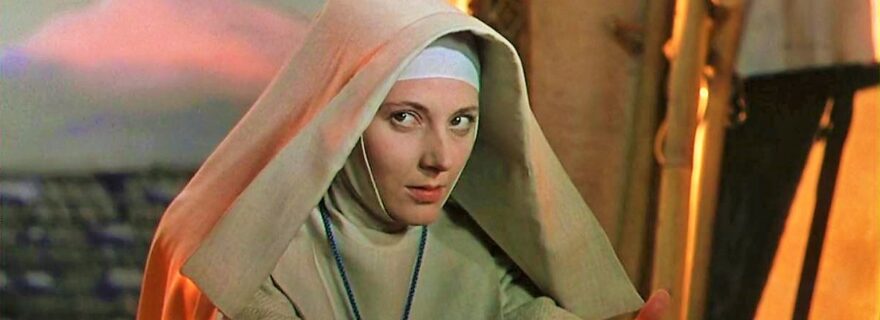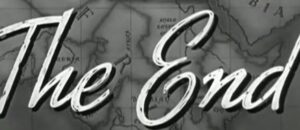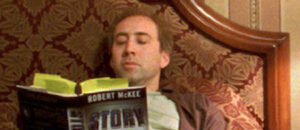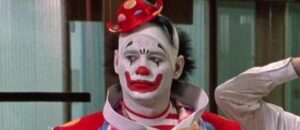The Oscar committee has decided that the Best Cinematography category is no longer worthy of being televised. Let’s use this week’s Roundtable to remind them how important photography is to the art of motion picture storytelling, whether our choices won awards or not.
Deirdre Crimmins
Of course cinematography is important! Film is a visual medium, and the best movies use this vantage to communicate much more than just a play on screen. The first example that leaps to mind of this is one of my favorite films, The Third Man. Carol Reed’s 1949 noir dark comedy is one of the cinematic pillars holding up modern filmmaking, and it does so by using every single frame to tell a story. It’s beautifully shot (you only need to revisit the sewer chase scene to establish that), but it’s so much more than that. The moment we see Orson Welles on screen, the camera strikes a Dutch angle and rewrites the visual language of the entire film in just one cock of its kino eye. Simply put, The Third Man could have been an entirely different movie if different decisions were made by Robert Krasker, and there’s no doubt that his contributions directly impacted one of the greatest films of all time. It’s appalling to think that the Academy now thinks these artists should be relegated to a lesser stage to celebrate their craft.
Shannon Nutt
Imagine if after 14 nominations, we were not allowed to witness Roger Deakins finally win an Oscar for Best Cinematography (for Blade Runner 2049)? Moments like that (and for other categories) are about to be robbed from movie lovers everywhere thanks to the Academy’s recent decision.
That said, my love of cinematography and how it can be used to tell a great story dates back to Steven Spielberg’s Jaws.
There, cinematographer Bill Butler (who was snubbed of an Oscar nomination, and whose long and impressive résumé as a director of photography includes such movies as Rocky II through IV, Grease, and The Conversation) had to use the camera to give an impression of a shark that was almost never there (thanks to well-documented mechanical issues). His ability to bring a sense of terror to visuals along with the difficult task of shooting much of the movie on the water (back in the days when CGI was non-existent) has thrilled audiences for over 40 years. It’s one of the most impressive (and perhaps most underappreciated, as Spielberg often gets most of the kudos and credit) efforts by a cinematographer in movie history..
Brian Hoss
The medium of film, the movies that are produced, released, and consumed in this century and the last, continue to be one of the most, if not the most dominate form of cultural, artistic, and popular expression. I expect that these stories, these films, that have already lasted for decades will continue to be passed down to future generations much like the oral and written histories that have preceded this era. But it’s important to bear in mind that movies are a visual medium, and that visual storytelling is often what transcends the barriers of understanding that exist between the different languages, different backgrounds, and the different times of the respective viewers.
It’s possible the Oscar committee has decided that the Best Director category represents enough of the director’s influence on cinematography in the public’s mind that the Best Cinematography award can be downplayed further, but that’s perhaps only as true as the Best Picture category being representative of the Best Director award. Last year, Blade Runner 2049 won for Best Cinematography, beating out several impressive nominees, but at that same time, presenting visuals that do credit to the medium. Naturally, as the Oscars committee spurns recognizing Cinematography, I can’t help but think of the visually arresting The Fountain, which went without an Oscar nomination in 2006. There were several deserving films that year, yet I think The Fountain should have been recognized as it depends on its incredible cinematography to arguably a greater degree than that year’s winner, Pan’s Labyrinth. Frankly, I would suggest not only making sure that the Best Cinematography award remains in discussion, but actually increasing the amount of discourse (and related importance) for cinematography of the past and present.
M. Enois Duarte
Personally, I feel the Academy’s decision of awarding the category for cinematography during the commercial break as doubly offensive. Not only are viewers denied watching one of the most essential and creative aspects of the filmmaking arts be recognized, but the category remains one of the few areas where women are grossly underrepresented. It wasn’t until last year’s ceremonies that Rachel Morrison finally made cinema history, nominated for her work in Mudbound, but there are many more, some with decades-long careers, who have continuously been overlooked.
With this in mind, I want to give a shout-out to Maryse Alberti for her terrific work in Ryan Coogler’s Creed, a film most would not think of or acknowledge for its photography. However, the camerawork is absolutely beautiful, with several stunning moments that could easily serve as a piece of art one could hang in their room. The training montage sequence alone is quite mesmerizing and inspiring, but for me, the five-minute long take of Adonis’ fight is a thing of beauty. Many don’t understand the challenge of shooting fast action sequences like a boxing bout and the amount of work that goes into it, especially considering how often the camera moves between various close-ups of the fighters and the many medium to wide shots while maintaining excellent lighting of the entire action. I still believe Alberti’s photography in Creed is one of the worst Oscar snubs of that year.
Adam Tyner (DVDTalk)
There are so many movies that, when my thoughts turn to them, I’ll recall very specific moments: the emotional crescendo in a particularly outstanding performance, a dazzling burst of visual effects, a twist I could never have seen coming, and on and on.
That’s not the case with Black Narcissus. It’s a rare film that I can practically replay in its entirety in my head. I don’t simply mean the beats of the plot or particularly memorable lines of dialogue; Jack Cardiff’s cinematography is inexorably seared into my mind. Black Narcissus is the most beautifully photographed film I’ve ever witnessed. So much of the storytelling is conveyed through its visuals that you could mute the audio and effortlessly follow along. That Cardiff drew such inspiration from his favorite painters rather than other cinematographers is deeply felt. Whether it’s something as seemingly mundane as red lipstick or as astonishing as a bell on the edge of a towering cliff, every frame is impactful and unforgettable.
Josh Zyber
I feel like the Qatsi Trilogy, along with its spinoffs Baraka and Samsara, are gimmes for this question. The entire series is a showcase for gorgeous photography, some of nature and some of civilization, shot in a diverse array of locations around the world. The latter two were both photographed in 65mm and are particularly stunning.
Great cinematography isn’t just about beauty shots, however (even though the Academy voters frequently assume so). David Fincher’s Se7en is a fascinating experiment in exposing as little light as possible while still capturing a viewable image. The entire film is comprised of layers of darkness upon darkness, creating an oppressive atmosphere of doom and gloom in support of Fincher’s nihilistic vision for the serial killer thriller. Although not particularly bright or colorful, the world he conjures is still strangely beautiful in its dankness and misery. Photography like this is a real challenge to transfer to home video. Thankfully, the director-supervised Blu-ray has fathomless blacks, crisp whites, and exactly as much shadow detail as is needed exactly where it’s needed.
Your Turn
Tell us about the cinematography that has made an impression on you.





ChrisB
The first 10 minutes of The Revenant is one of the most insane displays of cinematography ever. I don’t love the movie but that opening sequence is masterclass.
photogdave
Where to start? Recently (Oscar winner) John Toll’s work on Mad Max: Fury Road was transformative.
Jordan Cronenweth should have won for Blade Runner.
I’m a big fan of “the Prince of Darkness” Gordon Willis for his work on The Godfather trilogy and various Woody Allen movies, especially Manhattan.
Wes Anderson movies have always been visually appealing and unique thanks to his collaborations with Robert Yeoman.
Robert Elswit has an impressive resume but my favourite work of his is Boogie Nights. His ability to capture the feel of the 70s and 80s with photography was so good you could almost smell the scenery! And I loved the shot where our POV goes inside the film camera and follows the light through the lens and gate onto the film. Brilliant!
Bolo
‘Apocalypse Now’ for sure. Storaro created amazingly atmospheric visuals with good variety to compliment the film’s episodic structure, and under pretty demanding circumstances. I do think Storaro is one of these revisionists who makes modern presentations of his films match his current style instead of how they looked in their day. So the blu ray of this film just has a different saturated look than the 35mm presentations that I grew up on. It’s not a huge deal since it still looks nice, it just takes a bit of getting used to.
Josh Zyber
AuthorOur shame campaign worked! 🙂
https://variety.com/2019/film/news/all-oscar-categories-to-air-live-after-hollywood-protest-1203141496/
Judas Cradle
“The Oscars will now run over three hours as a result, the source added, which upends a leading Academy goal of trimming the show to 180 minutes.”
Just cut the musical numbers, dummies.
Josh Zyber
AuthorThe musical numbers and the fucking montages, absolutely.
Ismael Garcia
Oh yes! Another vote for cutting the fucking montages
Julian
I seem to remember a few broadcasts in the past without musical numbers (I could be mistaken). Why did these shows run over three hours?
Josh
No mentions of Roger Deakins yet. Shocking. His work on No Country For Old Men is absolutely brilliant, as is most of his career. In the last 20 years or so I’d say Elswit gets my vote for There Will Be Blood.
Honorable mention to the 3-person crew that shot In The Mood For Love and Jean Rabier for The Umbrellas Of Cherbourg
Josh Zyber
AuthorShannon mentioned Roger Deakins by name in his entry, and Brian also singled out Blade Runner 2049.
Josh
Right in the FIRST LINE! I need to go back to grade school to learn reading comprehension
Judas Cradle
It was a pretty dumb move.
I mean, filmmaking at its core is DIRECTING, CINEMATOGRAPHY and EDITING.
They were belittling TWO of those pillars.
Julian
Indeed. You can make a movie without make-up or music as a statement, but it’d be pretty hard/impossible without cinematography.
Josh Zyber
AuthorAlmost impossible:
https://en.wikipedia.org/wiki/Blue_(1993_film)
Julian
I thought you were referring to the Kieślowski movie (also from 1993!), and was confused, because that one definitely contains cinematography. But, indeed, Derek Jarman’s effort (previously unknown to me) is a whole different ball game.
Josh Zyber
AuthorJarman’s Blue – Now available on Blu-ray in stunning high definition!
http://www.amazon.co.uk/exec/obidos/ASIN/B07JYQN7T8/panandscathed-20
Trond Michelsen
I guess it depends on how you define cinematography.
I mean. If you just set up the camera, point it at the actors, and press “record”, without adjusting anything. Is that still cinematography? If it’s deliberate, and this is the look you want for the film, then it definately is. Otherwise, I guess it would be bad cinematography, but still cinematography.
Jon
Road to Perdition is still one of the most beautifully shot films I’ve ever seen.